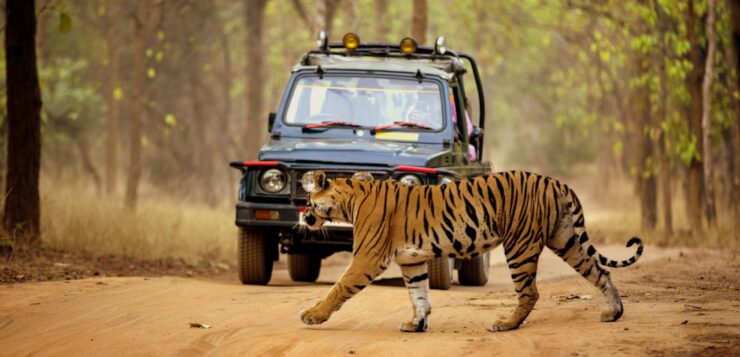A wide variety of animals may be
found in India thanks to its great biodiversity, but none is quite as famous
and magnificent as the Royal Bengal Tiger. For many wildlife fans, encountering
a tiger in its native environment is a dream comes true because of its powerful
presence and amazing beauty.
Luckily, there are several excellent places in India where you may raise
your chances of seeing these amazing animals. We’ll take you on a tour of some
of India’s top national parks and tiger reserves with this guide.
Uttarakhand’s Jim Corbett National Park
Jim Corbett National Park, the oldest national park in India, is home to one of the best tiger saviors in the nation. This park, named after well-known hunter-turned-environmentalist “Jim Corbett,” has a prosperous tiger population in addition to a wide variety of plants and animals.
If you want to see the entire zone of the park and have a better chance of seeing tigers, choose an elephant or jeep safari. This is a home for more than 650 beautiful and unique bird species.
There are various options to explore Jim Corbett National Park via jeep, canter, walk, or elephant safari. This place is composed of many natural beauty spots, such as dense forests, beautiful rivers, grasslands, etc.
This place is the best combination of flora and fauna, and to learn more about Jim Corbett, there is a museum through which you will get to know many things. And for the stay, there are various nearby resorts and hotels for rest, with top-class accommodations. The best part is that this place is near Delhi.
If you want to spend time in the natural surroundings, so you can book a resort in Jim Corbett for a stay. You can enjoy luxurious accommodations there for 2-3 days, whether you are going with your family, friends or it is simply a office trip, there all types of booking services available, from the resort you can also book for the Adventurous Jungle safari, via jeep or canter you can enjoy excellent service and encounters tigers with numerous animals and bird species.
Ranthambore National Park,
This place is named after the ancient Ranthambore Fort, which was constructed in the 10th century by the Chauhan dynasty. It shows three red stone temples honoring Ganesh, Shiva, and Ramlalaji, as well as a Digamber Jain temple honoring Sumatinatha and Sambhavanatha.
It covered an approximate area of 1,334 square kilometers, including the buffer zone. It is a portion of the Ranthambore Tiger Reserve. It features the red sandstone Jogi Mahal and Padam Talao, the park’s largest lake.
It is a place of impressive various types of animals, including more than 270 species of birds and the Bengal tiger population. There are more than 300 species of trees, of which over 100 are medicinal trees. The scenery of the park includes rocky terrain, open bushland, and lush, dry forests. This place is best suited for flora and fauna lovers. You people are going to love this place.
Bandhavgarh National Park in Madhya Pradesh
The world’s largest population of Bengal tigers may be found in Bandhavgarh National Park, a wildlife sanctuary in Madhya Pradesh, India’s Umaria district.
With an area of more than 716 square kilometers, the park is home to a wide variety of animals, such as spotted deer, wild pigs, leopards, Bengal tigers, and other bird species.
The park’s wild scenery and ancient landmarks, such as the Bandhavgarh Fort, provide an open view of the surroundings. Photographers and wildlife lovers crowed to view the tigers and inspire people to be saviors.
Kanha Tiger Reserve
In Madhya Pradesh, India, Kanha Tiger Reserve, formerly called Kanha-Kisli National Park, is the biggest national park. The park is split into two protected areas, Hallon and Banjar, which have respective areas of 250 and 300 square kilometers.
The reserve is known for its wide diversity of flora and animals, as well as its evergreen beauty. With a land area of 940 square kilometers, the central region, Kanha National Park, is home to 100 leopards and 125 tigers.
The southern swamp deer, or barasingha, is a species that is unique to the area and is supported in large numbers by the reserve. In addition to tigers and leopards, wildlife lovers may get the chance to see animals such as Indian deer as well as birds such as the Indian bird species paradise flycatcher. With its lush sal and bamboo trees that are a similar elaboration of Rudyard Kipling’s “The Jungle Book,” Kanha is essential to the survival of tigers and the preservation of biodiversity.
Sundarbans National Park of West Bengal
Situated in the South 24 Parganas
district of West Bengal, the Sundarbans National Park is home to the Royal
Bengal Tiger and a UNESCO World Heritage Site. There are various types of birds
and reptiles, including the salt-water crocodile, that live in an area. The
main portion of the Sundarban Tiger Reserve was established in 1973, marking
the beginning of the park’s existence.
It received the designation of a wildlife sanctuary in 1977. It was designated
as a national park in 1984.
The Sundarbans have been acknowledged as a Ramsar site since 2019, underscoring
their significance on a global scale.
In summary,
There are few opportunities like this to see the grace and majesty of the Royal Bengal Tiger in its native environment, as there are in India’s tiger reserves and national parks.
Every area offers an incredible wildlife experience, whether you’re traveling through the rivers of the Sundarbans or the deep jungles of Jim Corbett.
So gather your belongings, go on a safari, and see the fascinating world of India’s tigers. Who knows? It’s possible that you will come upon the magnificent monarch of the forest.




